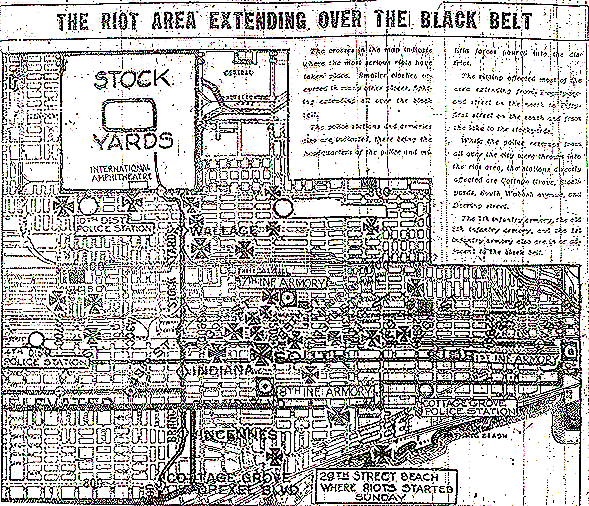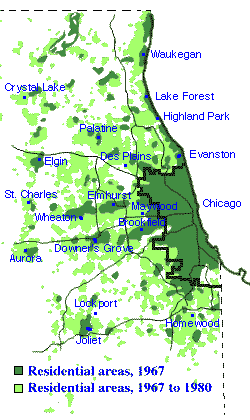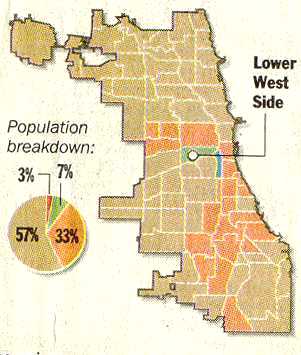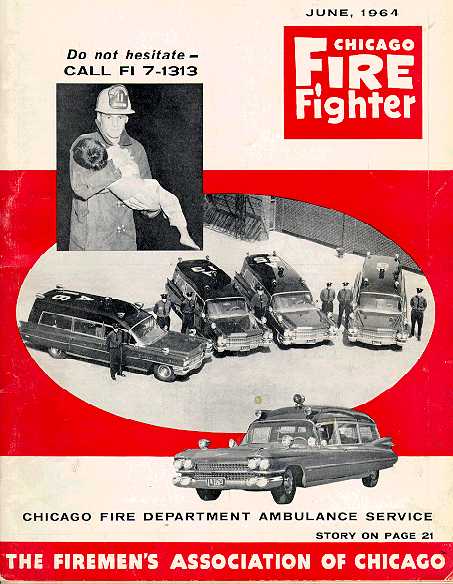Ethnic Tensions in Chicago
Tensions between the various racial and ethnic groups in Chicago have existed for almost as long as the city of Chicago itself. As the city grew with the development of the Illinois and Michigan Canal in 1848, the coming of railroads in the early 1850s, and the opening of the Union Stock Yards in 1865, so too did its economic opportunities; attracting immigrants from Ireland, Germany and Scandinavia. (2) "As early as the 1850s, a community of African Americans had settled along Lake and Kinzie Streets. Thousands of Irish, German, French, Bohemian, an d Scandinavian immigrants also began to settle west of the river during this decade, near the lumberyards, foundries, and flour mills that had
sprung up
there." (3) As the city's reputation grew from "a port and trading center for raw materials from the Midwest and finished goods from the East" to "a national railroad junction and an important manufacturing center" (2), this cultural diversity expanded to include Poles, Serbs, Russians, Czechs, Lithuanians, Italians, Greeks and Jews. Mexican immigrants first began coming to the city in the 1910, in an effort to flee the Mexican Revolution. (4) The "melting pot" created by these mass immigrations was not a calm one. "Before World War II, Chicago was divided into ethnic enclaves that were bitterly mistrustful of their neighbors on all sides. When an Irish neighborhood adjoined a Slavic one, or a Polish neighborhood adjoined a Scandinavian one, the fault lines were clear and the animosities barely restrained." (5) Groups of immigrants--usually white--who were "there first" often resented newcomers for taking the job opportunities they felt were rightfully theirs. When the Great Migration--a mass movement north by Southern African Americans seeking better opportunities--began at around the time of World War I (1914-1918), the situation only worsened, culminating in the race riots of 1919 which left 38 dead, 537 injured and 1,000 black families left homeless. (2)
d Scandinavian immigrants also began to settle west of the river during this decade, near the lumberyards, foundries, and flour mills that had
sprung up
there." (3) As the city's reputation grew from "a port and trading center for raw materials from the Midwest and finished goods from the East" to "a national railroad junction and an important manufacturing center" (2), this cultural diversity expanded to include Poles, Serbs, Russians, Czechs, Lithuanians, Italians, Greeks and Jews. Mexican immigrants first began coming to the city in the 1910, in an effort to flee the Mexican Revolution. (4) The "melting pot" created by these mass immigrations was not a calm one. "Before World War II, Chicago was divided into ethnic enclaves that were bitterly mistrustful of their neighbors on all sides. When an Irish neighborhood adjoined a Slavic one, or a Polish neighborhood adjoined a Scandinavian one, the fault lines were clear and the animosities barely restrained." (5) Groups of immigrants--usually white--who were "there first" often resented newcomers for taking the job opportunities they felt were rightfully theirs. When the Great Migration--a mass movement north by Southern African Americans seeking better opportunities--began at around the time of World War I (1914-1918), the situation only worsened, culminating in the race riots of 1919 which left 38 dead, 537 injured and 1,000 black families left homeless. (2)
 The next major shift in ethnic populations came after World War II, when whites moved out to the suburbs and increased numbers of blacks and Hispanics moved into formerly white residential areas to replace them. (2) Such gradual changes in the ethnicity of Chicago's ethnic neighborhoods lent itself to a new kind of tension, as "good" (i.e., light-skinned) citizens fled to more and more new places to escape the influx of "bad" (dark-skinned) newcomers. When Latin Americans began to arrive in the Pilsen area of Chicago in significant numbers, what is now one of the largest Mexican communities in the United States was composed mainly of Poles, Czechs and Germans, among other European ethnicities (6). This became basically the trend for the movement and exp
The next major shift in ethnic populations came after World War II, when whites moved out to the suburbs and increased numbers of blacks and Hispanics moved into formerly white residential areas to replace them. (2) Such gradual changes in the ethnicity of Chicago's ethnic neighborhoods lent itself to a new kind of tension, as "good" (i.e., light-skinned) citizens fled to more and more new places to escape the influx of "bad" (dark-skinned) newcomers. When Latin Americans began to arrive in the Pilsen area of Chicago in significant numbers, what is now one of the largest Mexican communities in the United States was composed mainly of Poles, Czechs and Germans, among other European ethnicities (6). This became basically the trend for the movement and exp ansion of Chicago's Latino communities, even to this day: in recent years, the formerly Polish Belmont Cragin area of Chicago has turned into essentially a Latin American community, inciting "the racial tensions that typically mark a community in transition" (7) if not the explosive violence of the 1919 Race Riots. It's the same story that has been repeated since the beginning of Chicago's immigration history: the newcomers (Latin Americans, in this case) come to new communities in search of a better place to live, while the current residents flee or fight back, fearing increased crime and decreased property values.
ansion of Chicago's Latino communities, even to this day: in recent years, the formerly Polish Belmont Cragin area of Chicago has turned into essentially a Latin American community, inciting "the racial tensions that typically mark a community in transition" (7) if not the explosive violence of the 1919 Race Riots. It's the same story that has been repeated since the beginning of Chicago's immigration history: the newcomers (Latin Americans, in this case) come to new communities in search of a better place to live, while the current residents flee or fight back, fearing increased crime and decreased property values.
The House On Mango Street discusses this phenomenon in the story Cathy, Queen of Cats:
"You want a friend, she says. Okay, I'll be your friend. But only till next Tuesday. That's when we move away. Got to. Then as if she forgot I just moved in, she says the neighborhood is getting bad .
Cathy's Father will have to fly to France one day and find her great great distant grand cousin on her father's side and inherit the family house. How do I know this is so? She told me so. In the meantime they'll just have to move a little farther north from Mango Street, a little farther away every time people like us keep moving in." (1)
Cathy's family leaving Mango Street is representative of many real-life white families' migration to greener (whiter?) pastures, in the city limits and beyond. After decades of further immigration and continued white flight, the 2000 census showed Hispanics making up a full 26 percent of the city's population. (2) And with that same census showing a population increase for the first time in 50 years (since the original influx of Hispanic immigrants, in fact), these numbers are only likely to increase. Does that mean increased ethnic tensions are also in store?
Beneath Chicago's celebrated tradition of ethnic neighborhoods (including those discussed in Mango Street and other works of Chicago literature) has always lurked a darker history of ethnic tension between the diverse groups. In fact, the tendency in Chicago for neighborhoods to divide themselves unde r (albeit constantly shifting) ethnic lines has led to a near-fixation on the origins and backgrounds of the city's denizens. "There may not be another city in America where ethnic labels are more important than they are in Chicago. Talk to anyone in almost any neighborhood, and somewhere early on you'll get the message that where your ancestors came from is somehow still important. Third persons mentioned in conversations will probably be referred to with an ethnic prefix: 'That Irishman, O'Hara,' or 'That Polack, Rudzinski.' Your grandfather may have come here from Sicily in 1895, but you're still likely to be known as 'that Eye-talian guy' or 'that Dago.'" (8) Such a tendency toward labelling can lead to resentments lingering from a history of racial mistrust and occasionally violence, as in the recent controversy where racial slurs were broadcast over the city's Fire Department radio. However, in a way it was necessary for the rich cultural milieu of today's Chicago to suffer from these traumatic birthing pains, and for every unfortunate clash on the way, the city progresses into further tolerance and diversity.
r (albeit constantly shifting) ethnic lines has led to a near-fixation on the origins and backgrounds of the city's denizens. "There may not be another city in America where ethnic labels are more important than they are in Chicago. Talk to anyone in almost any neighborhood, and somewhere early on you'll get the message that where your ancestors came from is somehow still important. Third persons mentioned in conversations will probably be referred to with an ethnic prefix: 'That Irishman, O'Hara,' or 'That Polack, Rudzinski.' Your grandfather may have come here from Sicily in 1895, but you're still likely to be known as 'that Eye-talian guy' or 'that Dago.'" (8) Such a tendency toward labelling can lead to resentments lingering from a history of racial mistrust and occasionally violence, as in the recent controversy where racial slurs were broadcast over the city's Fire Department radio. However, in a way it was necessary for the rich cultural milieu of today's Chicago to suffer from these traumatic birthing pains, and for every unfortunate clash on the way, the city progresses into further tolerance and diversity.
* Race Riot image: O'Brien, Ellen and Lyle Benedict. 1919: Race Riots. Deaths, Disturbances, Disasters and Disorders in Chicago. Chicago Public Library. Online. 4/2/2004.
* Chicago Suburbs image: Growth of the Suburbs. At Home in a House Subdivided: 1950-Present. Illinois State Museum. Online. 4/7/2004.
* Fire Department image: June 1964 cover of "The Chicago Fire Fighter" featuring the Chicago Fire Department ambulance service. Northland Chapter of the Professional Car Society Museum. Online. 4/7/2004.
Home
 d Scandinavian immigrants also began to settle west of the river during this decade, near the lumberyards, foundries, and flour mills that had
sprung up
there." (3) As the city's reputation grew from "a port and trading center for raw materials from the Midwest and finished goods from the East" to "a national railroad junction and an important manufacturing center" (2), this cultural diversity expanded to include Poles, Serbs, Russians, Czechs, Lithuanians, Italians, Greeks and Jews. Mexican immigrants first began coming to the city in the 1910, in an effort to flee the Mexican Revolution. (4) The "melting pot" created by these mass immigrations was not a calm one. "Before World War II, Chicago was divided into ethnic enclaves that were bitterly mistrustful of their neighbors on all sides. When an Irish neighborhood adjoined a Slavic one, or a Polish neighborhood adjoined a Scandinavian one, the fault lines were clear and the animosities barely restrained." (5) Groups of immigrants--usually white--who were "there first" often resented newcomers for taking the job opportunities they felt were rightfully theirs. When the Great Migration--a mass movement north by Southern African Americans seeking better opportunities--began at around the time of World War I (1914-1918), the situation only worsened, culminating in the race riots of 1919 which left 38 dead, 537 injured and 1,000 black families left homeless. (2)
d Scandinavian immigrants also began to settle west of the river during this decade, near the lumberyards, foundries, and flour mills that had
sprung up
there." (3) As the city's reputation grew from "a port and trading center for raw materials from the Midwest and finished goods from the East" to "a national railroad junction and an important manufacturing center" (2), this cultural diversity expanded to include Poles, Serbs, Russians, Czechs, Lithuanians, Italians, Greeks and Jews. Mexican immigrants first began coming to the city in the 1910, in an effort to flee the Mexican Revolution. (4) The "melting pot" created by these mass immigrations was not a calm one. "Before World War II, Chicago was divided into ethnic enclaves that were bitterly mistrustful of their neighbors on all sides. When an Irish neighborhood adjoined a Slavic one, or a Polish neighborhood adjoined a Scandinavian one, the fault lines were clear and the animosities barely restrained." (5) Groups of immigrants--usually white--who were "there first" often resented newcomers for taking the job opportunities they felt were rightfully theirs. When the Great Migration--a mass movement north by Southern African Americans seeking better opportunities--began at around the time of World War I (1914-1918), the situation only worsened, culminating in the race riots of 1919 which left 38 dead, 537 injured and 1,000 black families left homeless. (2) The next major shift in ethnic populations came after World War II, when whites moved out to the suburbs and increased numbers of blacks and Hispanics moved into formerly white residential areas to replace them. (
The next major shift in ethnic populations came after World War II, when whites moved out to the suburbs and increased numbers of blacks and Hispanics moved into formerly white residential areas to replace them. ( ansion of Chicago's Latino communities, even to this day: in recent years, the formerly Polish Belmont Cragin area of Chicago has turned into essentially a Latin American community, inciting "the racial tensions that typically mark a community in transition" (
ansion of Chicago's Latino communities, even to this day: in recent years, the formerly Polish Belmont Cragin area of Chicago has turned into essentially a Latin American community, inciting "the racial tensions that typically mark a community in transition" ( r (albeit constantly shifting) ethnic lines has led to a near-fixation on the origins and backgrounds of the city's denizens. "There may not be another city in America where ethnic labels are more important than they are in Chicago. Talk to anyone in almost any neighborhood, and somewhere early on you'll get the message that where your ancestors came from is somehow still important. Third persons mentioned in conversations will probably be referred to with an ethnic prefix: 'That Irishman, O'Hara,' or 'That Polack, Rudzinski.' Your grandfather may have come here from Sicily in 1895, but you're still likely to be known as 'that Eye-talian guy' or 'that Dago.'" (
r (albeit constantly shifting) ethnic lines has led to a near-fixation on the origins and backgrounds of the city's denizens. "There may not be another city in America where ethnic labels are more important than they are in Chicago. Talk to anyone in almost any neighborhood, and somewhere early on you'll get the message that where your ancestors came from is somehow still important. Third persons mentioned in conversations will probably be referred to with an ethnic prefix: 'That Irishman, O'Hara,' or 'That Polack, Rudzinski.' Your grandfather may have come here from Sicily in 1895, but you're still likely to be known as 'that Eye-talian guy' or 'that Dago.'" (